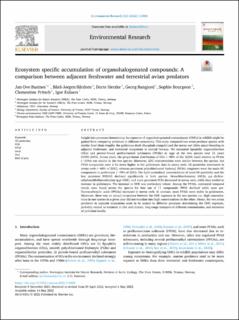| dc.contributor.author | Bustnes, Jan Ove | |
| dc.contributor.author | Bårdsen, Bård-Jørgen | |
| dc.contributor.author | Herzke, Dorte | |
| dc.contributor.author | Bangjord, Georg | |
| dc.contributor.author | Bourgeon, Sophie | |
| dc.contributor.author | Fritsch, Clémentine | |
| dc.contributor.author | Eulaers, Igor | |
| dc.date.accessioned | 2022-11-22T10:22:12Z | |
| dc.date.available | 2022-11-22T10:22:12Z | |
| dc.date.created | 2022-06-13T10:26:34Z | |
| dc.date.issued | 2022 | |
| dc.identifier.citation | Environmental Research. 2022, 212, 113455. | en_US |
| dc.identifier.issn | 0013-9351 | |
| dc.identifier.uri | https://hdl.handle.net/11250/3033335 | |
| dc.description.abstract | Insight into processes determining the exposure of organohalogenated contaminants (OHCs) in wildlife might be gained from comparing predators in different ecosystems. This study compared two avian predator species with similar food chain lengths: the goldeneye duck (Bucephala clangula) and the tawny owl (Strix aluco) breeding in adjacent freshwater- and terrestrial ecosystems in central Norway. We measured lipophilic organochlorines (OCs) and protein-bound perfluorinated substances (PFASs) in eggs of the two species over 21 years (1999–2019). Across years, the proportional distribution of OCs (∼90% of the ΣOHC load) relative to PFASs (∼10%) was similar in the two species. Moreover, ΣOC concentrations were similar between the species, but PFAS compounds were 2–12 times higher in the goldeneyes than in tawny owls. OC-pesticides dominated in tawny owls (∼60% of ΣOC), whereas persistent polychlorinated biphenyl (PCBs) congeners were the main OC components in goldeneyes (∼70% of ΣOC). The lipid-normalized concentrations of most OC-pesticides and the less persistent PCB101 declined significantly in both species. Hexachlorobenzene (HCB), p,p’-dichlorodiphenyldichloroethylene (p,p’-DDE), and more persistent PCBs decreased in tawny owls, while they tended to increase in goldeneyes. The increase in HCB was particulary robust. Among the PFASs, contrasted temporal trends were found across the species for four out of 11 compounds: PFOS declined while most perfluorocarboxylic acids (PFCAs) increased in tawny owls. In contrast, most PFASs were stable in goldeneyes. Moreover, there was no annual covariance between the OHC exposure in the two species: i.e., high concentrations in one species in a given year did not translate into high concentrations in the other. Hence, the two avian predators in adjacent ecosystems seem to be subject to different processes determining the OHC exposure, probably related to variation in diet and climate, long-range transport of different contaminants, and emissions of pollution locally. | en_US |
| dc.language.iso | eng | en_US |
| dc.rights | Navngivelse 4.0 Internasjonal | * |
| dc.rights.uri | http://creativecommons.org/licenses/by/4.0/deed.no | * |
| dc.title | Ecosystem specific accumulation of organohalogenated compounds: A comparison between adjacent freshwater and terrestrial avian predators | en_US |
| dc.title.alternative | Ecosystem specific accumulation of organohalogenated compounds: A comparison between adjacent freshwater and terrestrial avian predators | en_US |
| dc.type | Peer reviewed | en_US |
| dc.type | Journal article | en_US |
| dc.description.version | publishedVersion | en_US |
| dc.rights.holder | © 2022 The Authors. Published by Elsevier Inc. | en_US |
| dc.source.volume | 212 | en_US |
| dc.source.journal | Environmental Research | en_US |
| dc.identifier.doi | 10.1016/j.envres.2022.113455 | |
| dc.identifier.cristin | 2031298 | |
| dc.relation.project | Norges forskningsråd: 268482 | en_US |
| dc.relation.project | Norges forskningsråd: 287114 | en_US |
| dc.relation.project | NILU: 117068 | en_US |
| dc.source.articlenumber | 113455 | en_US |
| cristin.ispublished | true | |
| cristin.fulltext | original | |
| cristin.qualitycode | 2 | |

